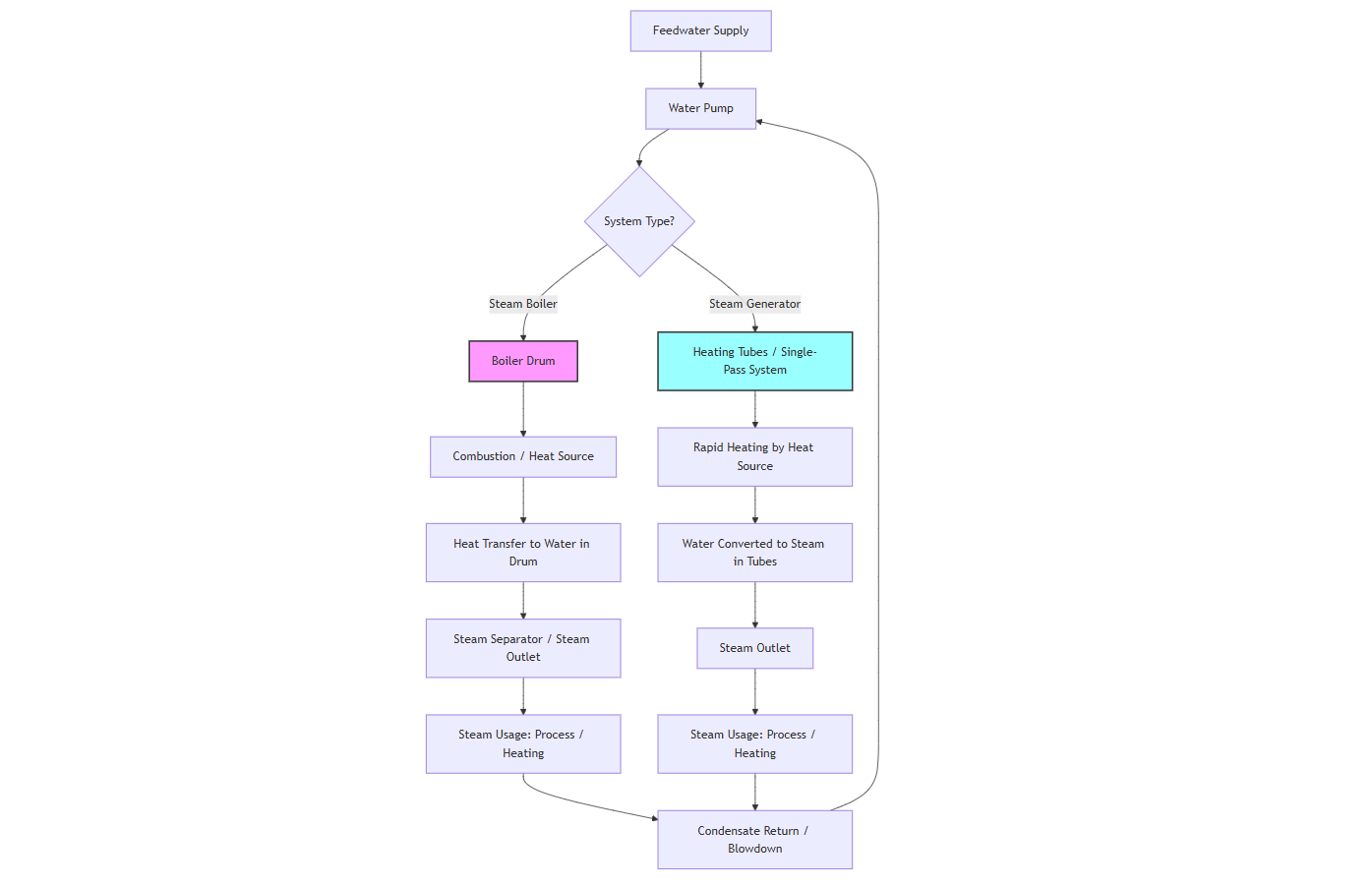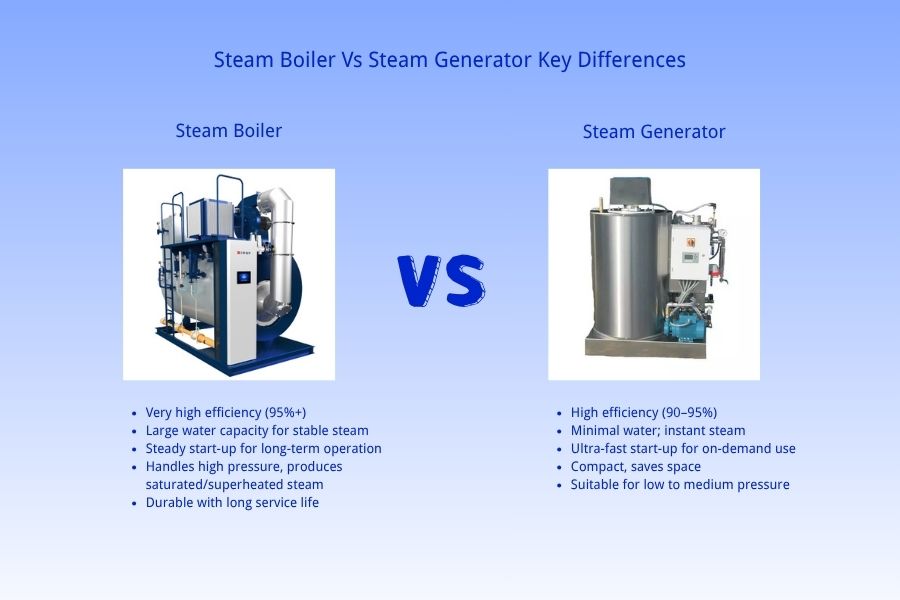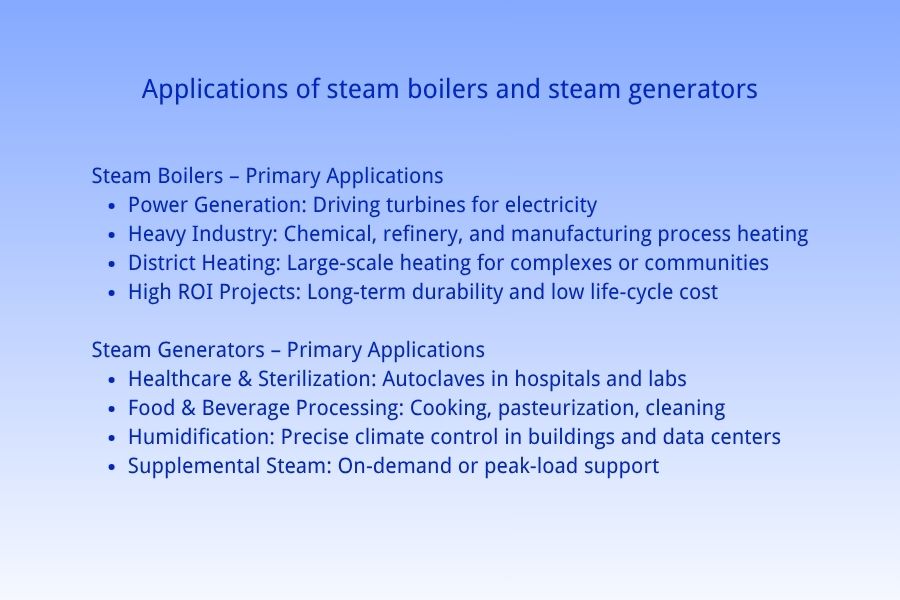The decision between a steam boiler and steam generator is a critical one for many industrial, commercial, and institutional applications. While both pieces of equipment are designed to produce steam, they do so through fundamentally different engineering approaches, leading to significant differences in operation, efficiency, and suitability. This in-depth guide will explore the core principles, key differences, and ideal applications for both systems to help you answer the pivotal question: should you choose a steam boiler or steam generator?
What is a Steam Boiler and Steam Generator?
To understand the choice, we must first define the two technologies clearly.
A steam boiler is a closed vessel where water is heated beyond its boiling point to generate steam. The term “boiler” is traditional and encompasses a wide range of designs, most notably fire-tube and water-tube boilers. The key characteristic of a steam boiler is that it contains a significant amount of water, which is stored under pressure and continuously heated. Modern steam boilers, especially those from leading manufacturers, have undergone significant technological evolution. They now incorporate advanced condensing technology, intelligent combustion control, and high-efficiency heat exchangers, allowing them to achieve remarkable thermal efficiency levels that compete with the most modern alternatives. This large water volume acts as a thermal energy reservoir, allowing the system to respond to fluctuating steam demands effectively. Steam boilers are known for their robustness, longevity, and ability to handle high-pressure, high-capacity requirements.
In contrast, a steam generator is a more modern and compact piece of equipment designed to produce steam rapidly and with high thermal efficiency. The fundamental distinction lies in its design: a steam generator does not store a large volume of water. Instead, it uses a series of coils and a single-pass, forced-flow system. Water is pumped through these coils and is instantaneously vaporized upon heating. This “once-through” design eliminates the need for a large pressure vessel and results in a smaller footprint and faster startup times compared to a traditional steam boiler.
How Do Steam Boilers and Steam Generators Work?
The working principles of these two systems highlight their core differences.
A traditional steam boiler operates on a batch-process principle. In a fire-tube boiler, hot gases from the burner pass through tubes that are surrounded by water in the main vessel. The heat is transferred through the tube walls, heating the water and generating steam, which collects in the steam drum above the water level. In a water-tube boiler, the setup is reversed: water flows inside the tubes, and the hot combustion gases surround them. In both types, the steam produced is separated from the water in the drum and then sent to the point of use. The large mass of water in the steam boiler provides inherent stability and can tolerate short-term demand spikes without a significant pressure drop. Modern high-efficiency boilers enhance this process with features like economizers that pre-heat feedwater using exhaust gases and condensing flue gas heat recovery systems that capture latent heat, pushing efficiency to 95% and beyond.
The operation of a steam generator is a continuous, linear process. Feedwater is precisely controlled and pumped into a single, coiled tube. As the water travels through this coil, it passes through three distinct stages in sequence: the economizer section (pre-heating), the evaporator section (where it turns into steam), and the superheater section (where the steam is dried and its temperature is raised above saturation point). Since there is no steam drum and no water storage, the steam is generated almost instantly. This forced-circulation design of the steam generator is key to its high efficiency and compact size.
What are the Key Differences Between a Steam Boiler and Steam Generator?
Understanding the distinctions is crucial for making an informed decision. The table below summarizes the primary differences, highlighting the advancements in modern boiler technology.
| Feature | Modern High-Efficiency Steam Boiler | Steam Generator |
|---|---|---|
| Thermal Efficiency | Very High (95%+ achievable). Advanced condensing technology and heat recovery systems maximize fuel-to-steam efficiency, ensuring low operational costs. | Very High (often 90-95%+). Inherently efficient due to the once-through design. |
| Water Holding Capacity | Large. Acts as a stable heat reservoir, smoothing out demand fluctuations and providing system inertia. | Very small or minimal. “Once-through” design with no storage capacity. |
| Start-up Time | Steady and Robust (minutes). Designed for stable, long-term operation. Modern controls optimize warm-up cycles. | Very Fast (seconds to minutes). Ideal for instant, on-demand steam needs. |
| Footprint & Size | Robust design, requires dedicated space. A long-term investment in infrastructure. | Compact and modular, requiring significantly less floor space. |
| Steam Quality & Pressure | Excels in High-Pressure Applications. Reliably produces saturated or superheated steam for the most demanding industrial processes. | Generally suited for low to medium pressure applications. Can produce superheated steam. |
| System Durability & Lifecycle | Long Service Life. Built with robust materials for decades of reliable service, offering an excellent long-term return on investment. | Compact design; longevity can be highly dependent on water quality and maintenance rigor. |
| Response to Load Changes | Stable and Buffered. The large water volume provides inherent stability against rapid load swings. | Immediate. Responds instantly to changes in demand due to minimal water content. |
What are the Primary Applications and Uses for Steam Boilers and Steam Generators?
The choice between a steam boiler and steam generator is often dictated by the application’s specific requirements.
Modern steam boilers are the workhorses of industries that demand reliability, high pressure, and maximum fuel efficiency over a long equipment life. Their ability to store energy and achieve top-tier efficiency makes them ideal for:
-
Power Generation: Driving turbines to produce electricity.
-
Heavy Industrial Processing: In chemical plants, refineries, and manufacturing facilities for process heating.
-
District Heating: Providing efficient, large-scale heat for complexes or communities.
-
Applications Requiring High ROI: Where low life-cycle cost and long-term durability are paramount.
Steam generators, with their rapid startup and compact form factor, excel in applications where steam is needed on-demand. Their common uses include:
-
Healthcare and Sterilization: Autoclaves in hospitals and laboratories require clean, dry steam quickly.
-
Food and Beverage Processing: For cooking, pasteurization, and cleaning where quick cycle times are crucial.
-
Humidification: For precise climate control in commercial buildings and data centers.
-
Supplemental or Peak Shaving: Providing additional steam capacity during temporary demand spikes.
How to Choose: Should I Select a Steam Boiler or Steam Generator?
The final decision hinges on a careful analysis of your operational needs. Answering the following questions will guide you toward the correct choice:
-
Is Long-Term Efficiency and ROI Your Top Priority? If your goal is the lowest total cost of ownership over a 15-30 year lifespan, a modern high-efficiency steam boiler with its 95%+ efficiency and proven durability is the unequivocal choice. It transforms fuel into steam with minimal waste, year after year.
-
What is your Steam Demand Profile? If you need a constant, high volume of steam, often at high pressures, a steam boiler is the more robust and stable solution. If your demand is highly intermittent with frequent startups and shutdowns, a steam generator will be more responsive.
-
How Quickly Do You Need Steam? For applications like hospital sterilization where steam is needed within minutes of a button press, the fast start-up of a steam generator is a decisive advantage. A steam boiler is designed for steady-state operation.
-
What are Your Space Constraints? If your facility has severe space limitations, the compact design of a steam generator is beneficial. However, a steam boiler is a permanent infrastructure investment that pays back in reliability and efficiency.
Conclusion: Making an Informed Investment
There is no one-size-fits-all answer in the steam boiler vs steam generator debate. The choice fundamentally comes down to your priorities. The steam generator is an agile, compact solution for on-demand steam. However, the modern high-efficiency steam boiler stands as the superior choice for operations prioritizing unparalleled thermal efficiency, long-term reliability, high-pressure capability, and the best possible return on investment over the entire lifecycle of the equipment. By thoroughly evaluating your steam demand patterns, efficiency goals, and long-term operational strategy, you can select the technology that truly optimizes your performance and profitability.
Frequently Asked Questions
Q1: Is a Steam Boiler vs Steam Generator safer?
Both steam boilers and steam generators are designed with multiple safety features and must comply with strict industrial codes. However, because a steam generator holds a much smaller volume of water and has lower water content than a steam boiler, it contains less potential energy. This reduces the risk in case of pressure vessel failure, making a steam generator inherently safer from catastrophic explosions. For industries evaluating steam boiler vs steam generator safety, the smaller water volume of the generator can be a significant advantage.
Q2: Which system has lower maintenance costs: Steam Boiler vs Steam Generator?
Maintenance profiles differ for steam boilers and steam generators. Steam boilers require regular descaling, blowdown, and inspection of their large pressure vessel, and effective water treatment is essential to prevent corrosion and scaling. Steam generators have fewer mechanical parts but rely on precise pumps and advanced controls. Their single-pass design can make them more sensitive to feedwater scaling, so high-quality water treatment is mandatory. Overall maintenance costs for steam boilers vs steam generators are comparable but depend heavily on water quality, usage, and system type.
Q3: Can a Steam Boiler vs Steam Generator replacement work for my facility?
In many cases, yes—especially for low- to medium-pressure steam boiler vs steam generator applications. A steam generator can serve as an excellent replacement or supplement, particularly if your steam usage has become intermittent or if you aim to save space and improve energy efficiency. A detailed system audit by a qualified engineer can determine the best option when comparing steam boilers and steam generators.
Q4: Which is more environmentally friendly: Steam Boiler vs Steam Generator?
Steam generators generally offer higher thermal efficiency (90–95%+), which translates to lower fuel consumption and reduced greenhouse gas emissions compared to traditional steam boilers. Their rapid start-up reduces energy waste during idle periods. Industries looking for high-efficiency steam solutions often find that a steam generator provides a greener alternative when comparing steam boilers vs steam generators.
Get your best price
Quickly compare 3 FREE quotes
- Engineer quick quote
- The overall delivery speed is fast
- Financial choice
- Low installation costs and cost savings
25 years+ of boiler R&D
More than 20 innovative technologies




